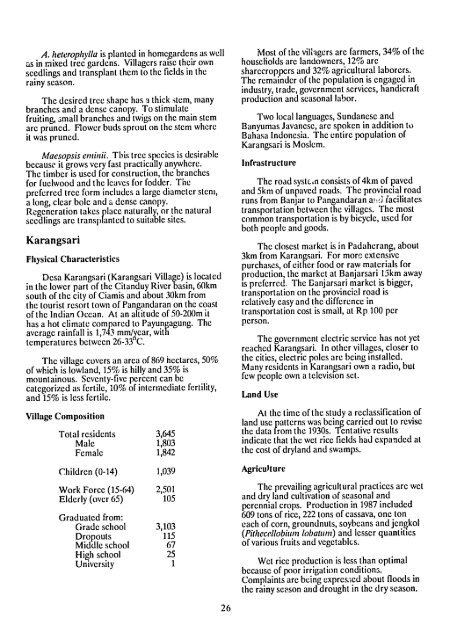multipurpose tree species research for small farms: strategies ... - part
multipurpose tree species research for small farms: strategies ... - part
multipurpose tree species research for small farms: strategies ... - part
Create successful ePaper yourself
Turn your PDF publications into a flip-book with our unique Google optimized e-Paper software.
A. heterophyla isplanted in homegardens as well<br />
as inmixed <strong>tree</strong> gardens. Villagers raise their own<br />
seedlings and transplant them to the fields in the<br />
rainy season.<br />
The desired <strong>tree</strong> shape has a thick stem, many<br />
branches and a dense canopy. To stimulate<br />
fruiting, ;mall branches and twigs on the main stem<br />
are pruned. Flower buds sprout on the stem where<br />
itwas pruned.<br />
Maesopsiseninii. Tiffs <strong>tree</strong> <strong>species</strong> is desirable<br />
because it grows very fast practically anywhere.<br />
The timber isused <strong>for</strong> construction, the branches<br />
<strong>for</strong> fuelwood and the leaves <strong>for</strong> fodder. The<br />
preferred <strong>tree</strong> <strong>for</strong>m includes a large diameter stem,<br />
a long, clear bole and a dense canopy.<br />
Regeneration takes place naturally, or the natural<br />
seedlings are transplanted to suitable sites.<br />
Karangsari<br />
Physical Characteristics<br />
Desa Karangsari (Karangsari Village) islocated<br />
in the lower <strong>part</strong> of the Citanduy River basin, 60km<br />
south of the city of Ciamis and about 30km from<br />
the tourist resort town of Pangandaran on the coast<br />
of the Indian Ocean. At an altitude of 50-200m it<br />
has a hot climate compared to Payungagung. The<br />
average rainfall is 1,743 mm/,ear, wit<br />
temperatures between 26-33 C.<br />
The village covers an area of869 hectares, 50%<br />
of which is lowland, 15% is hilly and 35% is<br />
mountainous. Seventy-five percent can be<br />
categorized as fertile, 10% of intermediate fertility,<br />
and 15% is less fertile.<br />
Village Composition<br />
Total residents 3,645<br />
Male<br />
1,803<br />
Female 1,842<br />
Children (0-14) 1,039<br />
Work Force (15-64)<br />
Elderly (over 65)<br />
2,501<br />
105<br />
Graduated from:<br />
Grade school 3,103<br />
Dropouts<br />
115<br />
Middle school 67<br />
High school 25<br />
University<br />
1<br />
26<br />
Most of the villagers are farmers, 34% of the<br />
households are landowners, 12% are<br />
sharecroppers and 32% agricultural laborers.<br />
The remainder of the population is engaged in<br />
industry, trade, government services, handicraft<br />
production and seasonal labor.<br />
Two local languages, Sundanese and<br />
Banyumas Javanese, are spoken in addition to<br />
Bahasa Indonesia. The entire population of<br />
Karangsari isMoslem.<br />
Infrastructure<br />
The road systcn consists of 4km of paved<br />
and 5km of unpaved roads. The provincial road<br />
runs from Banjar to Pangandaran a., facilitates<br />
transportation between the villages. The most<br />
common transportation isby bicycle, used <strong>for</strong><br />
both people and goods.<br />
The closest market isin Padaherang, about<br />
3km from Karangsari. For more extensive<br />
purchases, of either food or raw materials <strong>for</strong><br />
production, the market at Banjarsari 15km away<br />
is preferred. The Banjarsari market isbigger,<br />
transportation on the provincial road is<br />
relatively easy and the difference in<br />
transportation cost is<strong>small</strong>, at Rp 100 per<br />
person.<br />
The government electric service has not yet<br />
reached Karangsari. In other villages, closer to<br />
the cities, electric poles are being inslalled.<br />
Many residents in Karangsari own a radio, but<br />
few people own atelevision set.<br />
Land Use<br />
At the time of the study a reclassification of<br />
land use patterns was being carried out to revise<br />
the data from the 1930s. Tentative results<br />
indicate that the wet rice fields had expanded at<br />
the cost of dryland and swamps.<br />
Agriculture<br />
The prevailing agricultural practices are wet<br />
and dry land cultivation of seasonal and<br />
perennial crops. Production in 1987 included<br />
609 tons of rice, 222 tons of cassava, one ton<br />
each of corn, groundnuts, soybeans and jengkol<br />
(Pithecellobiumn lobattun) and lesser quantities<br />
of various fruits and vegetables.<br />
Wet rice production is less than optimal<br />
because of poor irrigation conditions.<br />
Complaints are being expres-ed about floods in<br />
the rainy season and drought in the dry season.

















